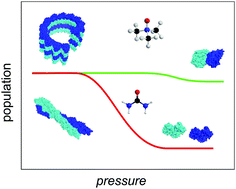Exploring the influence of natural cosolvents on the free energy and conformational landscape of filamentous actin and microtubules†
Abstract
Actin and tubulin, the main components of the cytoskeleton, are responsible for many different cellular functions and can be found in nearly all eukaryotic cells. The formation of filamentous actin (F-actin) as well as microtubules depends strongly on environmental and solution conditions. The self-assembly of both, actin and tubulin, has been found to be among the most pressure sensitive process in vivo. Here, we explored the effects of various types of natural cosolvents, such as urea and the osmolyte trimethylamine-N-oxide (TMAO), on the temperature- and pressure-dependent stability of their polymeric states, F-actin and microtubules. Accumulation of TMAO by deep-sea animals is proposed to protect against destabilizing effects of pressure. The pressure and temperature of unfolding as well as associated enthalpy and volume changes have been determined using Fourier-transform infrared spectroscopy, covering a wide range of pressures and temperatures, ranging from 1 bar to 11 kbar and from 20 to 90 °C, respectively. Complementary thermodynamic measurements have been carried out using differential scanning and pressure perturbation calorimetry. The results obtained helped us explore the effect of the cellular milieu on the limitations of the pressure stability of cytoskeletal assemblies. Conversely to urea, the pressure stability of both polymers increases dramatically in the presence of TMAO, counteracting detrimental effects of both, urea and pressure.



 Please wait while we load your content...
Please wait while we load your content...